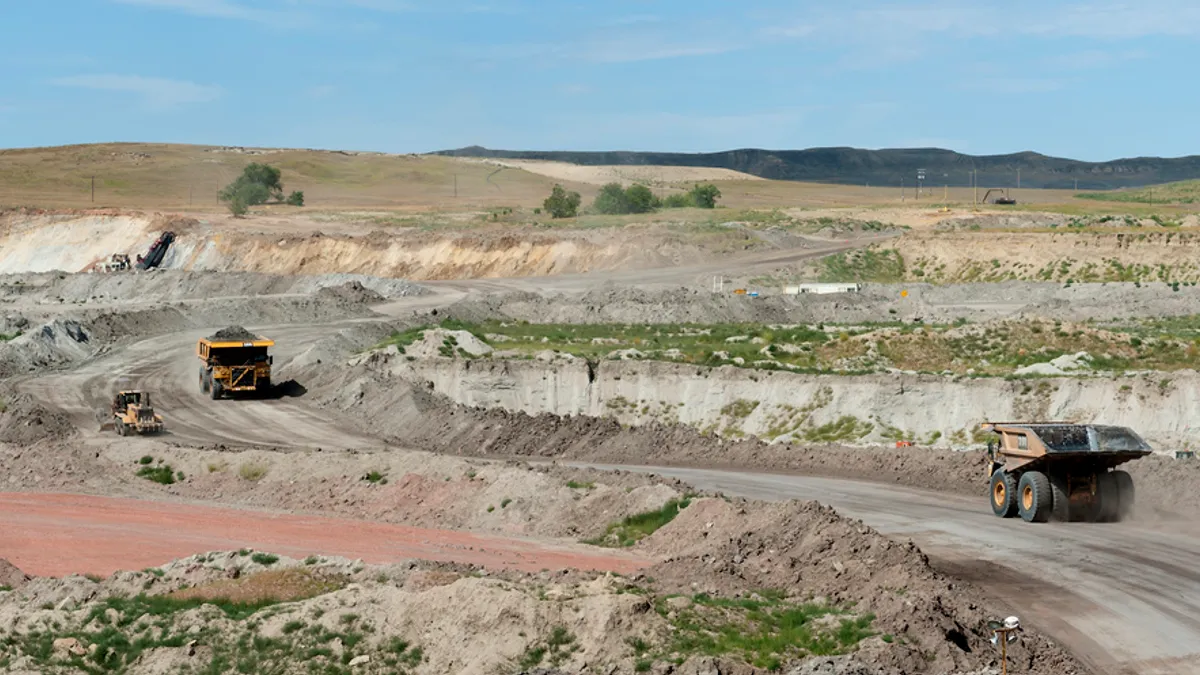Dive Brief:
-
Wyoming Gov. Matthew Mead, R, on Wednesday opened an industrial size laboratory that will test uses for carbon dioxide captured from power plants.
-
The Wyoming Integrated Test Center is attached to a coal-fired plant near Gillette, Wyo., and will assess if products using captured CO2 can move from laboratory to commercial scale.
-
The products being tested are the results of the NRG-COSIA Carbon XPrize — a $20 million competition sponsored by U.S. power company NRG Energy and Canada’s Oil Sands Innovation Alliance.
Dive Insight:
Capturing CO2 from power plants has been held up as one of the possible solutions to climate change. The technology has had a rocky road but is getting another chance thanks in part to the Trump administration.
The federal budget passed by Congress and signed by President Donald Trump in February included an extension of the 45Q tax credit for CO2 storage.
The 45Q tax credit, as well as federal grant money, were among the financial incentives behind two recent carbon capture and sequestration (CCS) projects that met very different ends.
Mississippi Power’s Kemper integrated gasification combined cycle plant would have used gasified lignite at the front end and captured the plant’s CO2 at the back end, but it was massively over budget and behind schedule. The utility finally pulled the plug on the $7.5 billion project last year.
The other project — and the only working CCS project in the U.S. to date — is the Petra Nova plant in Texas that was brought online last year by a joint venture of NRG Energy and JX Nippon Oil & Gas Exploration. The plant captures a portion of the CO2 emissions from a coal-fired unit at NRG's W.A. Parish plant. The CO2 is shipped about 80 miles via pipe to an oil field where it is injected into the wells in a process known as enhanced oil recovery, or EOR.
The Petra Nova plant relies on the price of oil to be economic. NRG last year said it was bullish on the technology, but it would not pursue another CCS project at current oil prices. At the time, oil prices were in the $45-55/barrel range. Oil this week broke through the $80/barrel mark.
"While higher oil prices are helpful, the economics of CCS EOR depend on many factors, including the source of the CO2, the technology to process it, proximity to oil reservoirs, oil prices and the geologic conditions and yield of the oil field," NRG spokesman David Knox told Utility Dive via email.
Sponsoring the XPrize was part of an effort to enhance the economics of carbon capture and help jump start the industry for future potential carbon capture development, Knox said.Currently EOR is the only process that has both an economic return and an appetite for extremely large quantities of carbon dioxide. The challenge with EOR is the volatility of oil prices and the need for carbon capture facilities to be located relatively close to mature oil fields, said Knox. If the XPrize can help develop new and multiple channels for using CO2, it can potentially improve the economic return while greatly enhancing the footprint of coal plants that could take advantage of carbon capture technologies, not just in America but around the world, he said. About 31% of NRG’s nearly 24 GW generation portfolio is fueled by coal.
Wyoming also has a stake in the new integrated test center near Gillette. The state produces about 40% of the coal used in U.S. power plants.
If the products that are going to be tested at the new facility turn out to be viable, it could make CCS a more economical option. But the challenge is significant. CCS plants require more energy to capture and process CO2, taking a toll on their efficiency. That raises the bar on the value that would need to be captured from any product that would use the captured CO2. Rather than being a cheap byproduct, CO2 from a CCS plant could be an expensive raw material.
The teams vying for the Carbon XPrize in the Wyoming track are from Canada, China, India, the U.S. and Scotland. The products they are testing include methanol made using captured CO2, bio-composite foamed plastics, solid carbonates with applications for building materials, a CO2 infused concrete, and building materials that absorb CO2.
The Wyoming test center where those products will be assessed for their ability to be produced at commercial scale was added on to Basin Electric Power Cooperative’s 422 MW coal plant, seven miles north of Gillette. The test center will use flue gas diverted from the coal plant.
The total cost of the test center is $21 million, of which $15 million came from the state of Wyoming and $6 million came from private sources, including the Tri-State Generation and Transmission Association and the National Rural Electric Cooperative Association. The actual construction cost was $12 million. The rest of the funds will be used for operation, maintenance and deconstruction, Jason Begger, executive director of the Wyoming Infrastructure Authority, told Utility Dive.
Each of the 10 finalists in the Carbon XPrize took home an equal share of the $5 million milestone prize. The $15 million grand prize is scheduled to be awarded in 2020.













